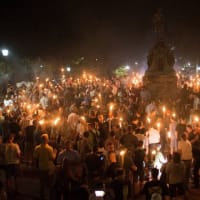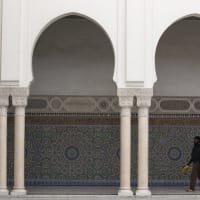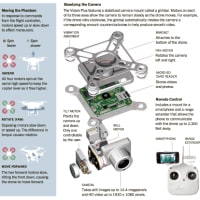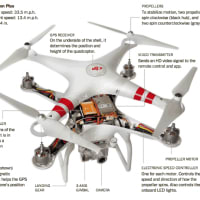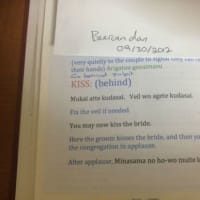The Road to Naypyidaw: What Hillary Clinton Will See in Burma
ネピドーへの道:ビルマでヒラリー・クリントンが見るものは
首都がネピドーというのは初耳だった、ラングーンとばかり思っていた。 ミャンマーの興味深い実態の一部が紹介されていたので翻訳してみた。独裁政権がやる開発は支配者が机上で計画し、強権をもって実施するので、こんな馬鹿でかいハイウエーなど建設してしまうが、当然ながら民意を反映していないので、実用に供さないものばかりとなる。東北の復興も東京で考えて安易に安全な高台など離れたところに漁師の住宅など集合住宅を建設したりしたら、後で使えないということにもなりかねない。地方の住宅は生活や仕事に密着していることは暮らしてみないとわからない。
Posted by HANNAH BEECH
Wednesday, November 30, 2011 at 3:08 am

A deserted 10 lanes highway in Naypyidaw. ネピドーの10車線の閑散とした幹線道路
As U.S. Secretary of State Hillary Clinton makes her historic visit to Burma from Nov. 30 to Dec. 2, she will be touring two vastly different cities. Clinton, the first U.S. Secretary of State to visit the isolated nation in more than half a century, first stops in Naypyidaw, the country's capital. The vast, surreal city, which means “the abode of the kings,” did not exist when Clinton's predecessor John Foster Dulles went to Burma, now known officially as Myanmar, back in 1955, before the country's military junta wrested control from a civilian government. In fact, Naypyidaw was only unveiled six years ago when a startled civil servant corps was told to pack their bags and head north from Burma's former capital, Rangoon. One cavalcade of trucks started on the road to the as-yet-unnamed city at the astrologically inspired time of 11 in the morning on Nov. 11 . Burma's then ruling junta was known to factor the stars into their leadership plans.
米国国務長官ヒラリー・クリントンは11月30日から12月2日までビルマへ歴史的な訪問をする。彼女は二つの大きく異なった都市を訪問する。 半世紀以上たったいま、この国際的に孤立した国家を国務長官として初めて訪問する。 最初の訪問地ネピドーはこの国の首都である。 広大な非現実的な都市、都市の名前の由来は「王族の住まい」を意味するが、クリントンの前任者であるジョン・フォスター・ダレスがビルマ(遡ること1955年、この国の軍事政権が国民政府から政権を奪って以来、今は公式にはミャンマーとして知られている。)を訪れたときには存在していなかった。 事実、ネピドーがベールを脱いだのはほんの6年前のことだった。 政府役人たちは、いきなり身辺の荷物をまとめて北へ向かうように指示されて、旧首都ラグーンを後にしたのである。 占星術のお告げに従い11月11日の午前11時に、彼らの引っ越しのトラックの長い車列が、まだ名前もついていない都市に向かったのである。 当時のビルマの軍事政権は星占いの結果を彼らの政策に反映していた。
No one is absolutely sure why Burma's generals, who earlier this year handed over power to a semi-civilian government still packed with army men, left bustling, dilapidated Rangoon. The official answer was that Rangoon had gotten too crowded. But other theories abound. The country's kings had a legacy of building grand capitals, like Ava and Mandalay, to preserve their legacy. The junta's chief Than Shwe, a reclusive general who is said to be a student of the country's royal history, may have wanted to add Naypyidaw to that royal building tradition.
今年の初めに、まだ多くの軍人を中に含む半民政政府に政権を移譲したビルマの将軍達が、なぜ、賑やかではるが、荒廃したラングーンを去ったのか誰もその理由を知っているものはいない。 公式の回答はラングーンが人口が増えすぎたということだった。 しかし、他の理屈が沢山ある。 この国の王族たちは、アバやマンダレイといったような彼らの遺産を残すための巨大な建造物の都市遺産を所有していた。 軍事政権の長であった孤高のテアン・シュエ将軍はこの国の王族の歴史の研究者でもあったと言われており、彼も、この王族の建造物の歴史の中にネピドーを遺したいと思ったのかも知れない。
Naypyidaw, which is situated on a vast plain overlooked by the Shan Hills in central Burma, is also far more bunkered than Rangoon, the southern trading port that was coaxed into relevance by the colonial British. For a clutch of battle-hardened generals, the fortress-like quality of their planned city—with a vast military zone inaccessible to normal citizens and honeycombed with tunnels and other martial trappings—must have been reassuring. Back when cyclone Nargis tore through lower Burma's Irrawaddy Delta in 2008, killing some 140,000 people, Naypyidaw was left unscathed. As the generals dallied on providing emergency aid to victims—a delay that cut short lives—speculation circulated in Burma that Western powers might invade to force the junta to save its beleaguered citizens. The rumors were, of course, fanciful. But surely the generals felt more immune to attack in their fortress capital than in Rangoon, which is more easily approachable by sea. (However, members of one ethnic group, which has on occasion raised a rebel militia, still roam the Shan Hills, proving that even Naypyidaw cannot be isolated from the ethnic troubles that continue to bedevil Burma.)
ネピドーは、ビルマ中央部のシャン山地を擁するビルマ中央部の広大な平野の中に位置し、植民時代の英国により導かれて首都となった南の貿易港であるラングーンよりも、はるかに堅固に守られている。 戦に明け暮れてきた将軍達にとって、要塞のように堅固な計画都市(通常の市民を寄せ付けない広大な軍事地帯や、蜂の巣状の地下トンネル、その他の軍事的配慮)はより安心なものに違いない。 2008年にイラワジデルタのビルマ低湿地を襲ったサイクロン・ナギロスで、14万人もの人々が亡くなったが、ネピドーは無傷だった。 将軍達が被災者への緊急援助をぐずぐずしていたとき(その遅れは多くの命を左右した)ビルマでは西側諸国が、苦境の市民を助けるよう軍事政権に強いるために、侵攻するという憶測が飛び交った。 その噂は、もちろん、幻想に終わったが、当時将軍達は、海から侵攻に弱いラングーンではなく、要塞都市にいることで攻撃に対して安心感は増したに違いない。 (しかしながら、ある少数民族のグループは反乱軍を時折動員して、いまだにシャン山地を根城に活動しており、ビルマを悩まし続けてきた少数民族内紛問題からネピドーは解放されているわけではない。)
When I first visited Naypyidaw in 2008, it was a vast, empty place with all the charm of a down-market American housing estate spread across a space so vast it takes an hour to cross by car. Street-sweepers languidly brushed dust off the six-lane highways. There was no need for them to get out of the middle of the road because so few cars traveled the spotless thoroughfares. A couple years later, I drove a juddering car up the new highway from Rangoon, passing young girls working in road-construction crews who were paid only $1.50 per day—if they were lucky enough to collect their wages. I expected that Naypidaw would have developed somewhat since then, but apart from a shopping center with video arcade and a massive parliament building, the city still felt vacant. Today the highways are still largely devoid of cars. Built just a few years ago, the civil servants' housing blocks—color-coded by government ministry—have weathered badly, their paint jobs bleached and left to decay, like victims of the sub-prime crisis. A Russian company will eventually build the country's first subway system in Naypyidaw, if local media is to be believed.
私が2008年にネピドーを訪れたとき、そこは広大な空き地が広がっており、アメリカの家屋の魅力的な大衆向けの市場(造成地)が広がっていた、そこはあまりに広く車で横切るだけで1時間はかかったほどだ。 道路の清掃車が適当に6車線の高速道路の塵を掃いていたが、車があまりに通らないので、その清掃車は、綺麗な幹線道路の真ん中を移動していられた。 2~3年後、私はぼろ車で新しい道をラングーンからドライブしたとき、若い少女たちが道路の建設作業員として一日僅か1.5ドルで働いている光景に出くわした。(それも、運よく賃金を貰えての話だが) 私は、当時に比べ、少しはネピドーが発展しているだろうと期待していたが、1つのゲームセンター付ショッピングセンターと大きな議会の建物を除いて、いまだにその都市はガランとしたままだった。 今でも、高速道路は殆ど車が走っていない。 数年前に建設された公務員の宿舎も(政府により色分けされているが)酷く雨曝しの状態で傷んでおり、ペンキは色褪せ、朽ちたままである。 それはサブプライム危機のときの廃屋のようにも見えた。 地方のメディアの言を信じるならば、ネピドーの国家初の地下鉄はロシアの企業が建設するとのことだ。
If this is the generals' dreamscape, then Naypyidaw speaks to peculiar priorities. There are several golf-courses, an air-conditioned enclave for penguins at the zoo and a scattering of immense government ministries marooned amid scrubland. But across the city, few people wander about. No one is here unless they have to be. Many civil servants have left their families back in Rangoon. Embassies have refused to move. Even the generals' children and grandchildren, the pampered princelings whose antics have shocked the Burmese populace, prefer to live in Rangoon. Naypyidaw has little nightlife to offer. On maps sold in the capital, the entire military zone is blank.
もし、これが将軍達の夢の地であるとするならば、ネピドーの都市建設の優先順位は特異でへんてこなものと言わざるを得ない。 そこには幾つかのゴルフコースがあり、エアコン付のペンギン棟がある動物園があり、政府の巨大な省庁の建物が低木地帯に散在している。 しかし、都市には殆ど人影を見ない。 居る必要がある人しか、住んでいないのだ。 多くの公務員でさえ、彼らの家族をラングーンに残して単身で来ている。 各国大使館も移転を拒否している。 ふざけた行為でビルマ市民を驚かせてきた、当の将軍達の甘やかされた、生意気な子供や孫たちもラングーンに住むことを望んでいる。 ネピドーにはナイトライフと呼ぶべきものは殆どなく、軍事地帯は空白になっており、地図上では売りに出ている。
The new capital does boast a towering replica of Rangoon's Shwedagon pagoda, the nation's holiest site. When I visited the Naypyidaw pagoda's construction site a few years back, I saw a row of children, some who looked no older than in first grade, carrying piles of rocks on stretchers. The straggle of youngsters was lined up like some surreal parody of a monastic processional. By the time the Naypyidaw Buddhist site was finished, real monks roamed the fancy new prayer halls with lavish gilt swirls. But the place had, as one pilgrim whispered to me, “no heart.”
新しい首都には、この国最も神聖な場所であるラングーンのシュワダゴン・パゴダのレプリカが聳え立っている。 私がネピドーの建設現場を数年前に訪れたとき、小学生にも満たない児童が列を作ってストレッチャーでブロックを積み上げて運んでいるのを見たが、苦役の子供達の列は、修道士の行列のパロディのような、幾分現実離れした光景に私の眼には映った。 その時には、ネピドーの仏陀の仏殿は完成しており、本当の僧侶が贅沢な錦糸の布を纏い、綺麗な新しい礼拝堂に集まっていましたが、そこには「心が無い」と、ある参拝者は私に呟いた。
By contrast, Rangoon, where Clinton will arrive on Dec. 1, is full of soul. A chaotic conurbation of some 5 million people, Burma's largest city was during British colonial times a polyglot metropolis with state-of-the-art infrastructure. Burma back then was one of the richest regions in Asia, blessed with fertile land and many natural resources. Following the military takeover in 1962, Rangoon, now known officially as Yangon, was preserved in amber for decades as the country isolated itself from the world. The nationalist regime ejected many Indian and Chinese residents in favor of the majority Bamar ethnicity, and the economy degenerated into one of the poorest in the world. But even today, amid the golden pagodas, there are hints of Rangoon's multicultural past: mosques and a Tamil temple, brick churches and a historic synagogue.
対照的に、クリントン国務長官が12月の1日に訪問するラングーンは魂が溢れている。 500万人有余の雑然とした大都市圏のビルマで最大の都市は、英国の統治時代、最先端のインフラを備えた多言語国際都市だった。 ビルマは、当時はアジアの中でも、肥沃な土地と豊富な天然資源に恵まれた最も裕福な地域だった。 しかし、1962年に軍事政権が政権を取り、ラングーン(今は公式にはヤンゴン)は、この国が世界から孤立するに従い、何十年もの間、まるで琥珀に閉じ込められた昆虫のように、時代から取り残されてしまったのだ。 国家主義の政権は多くのインド人や中国人の住民を追いだし、多数を占めるビルマ民族を優遇したため、経済は衰退し、世界でも一二を争う貧しい国になってしまった。 しかし、今日においてなお、数々の黄金のパゴダの中に混じって、ラングーンの多文化の過去が息づいているのも確かだ、それはモスクであり、タミール寺院であり、ブロック建ての教会であり、歴史を帯びたシナゴークなどである。
The city had not aged entirely gracefully; residents are occasionally killed when buildings collapse or naked power-lines electrocute passersby. Unlike Naypyidaw, which is bathed in 24-hour light, Rangoon suffers from chronic power cuts and wonky wiring. Walking at night, without the aid of streetlights, it's easy to trip over slabs of broken pavement or fall into uncovered sewers. One day I narrowly missed a chunk of concrete falling off a building near me. Instead, the piece of balcony slammed into a car next to me, smashing the windshield. The faces of decaying apartment blocks are striped with brightly colored strings to which plastic bags are attached, an ancient pulley system for those living on the higher floors. Nevertheless, Rangoon thrums with life, with people rushing to board the so-called “big belly” Chevrolet buses of mid-20th century vintage or lining up at street stalls to buy packets of betel nut and computer manuals that promise to teach “Latest Word Perfect Tips 1995.”
その都市は優雅に時代を刻んで行ったのではない。 住民は建物の崩壊に遭遇したり、裸の電力線に触れたりして死亡している。 24時間明るい照明の下にあるネピドーと違い、ラングーンは慢性的な停電とあてにならない送電網に悩まされている。夜に街灯のない中で歩いていると、舗装の壊れたブロックに躓くことは普通で、どうかするとカバーのない下水溝に落ちたりすることもある。ある日など、私は危うく落下するコンクリートのブロックに当たるところだった。 バルコニーの一部が車中の私の座席のすぐ横に崩落して、フロントガラスがめちゃくちゃに壊れたこともある。朽ちつつあるアパートのブロックの壁には、明るい色の紐が掛けられており、プラスチックのバックが取り付けられている。それらは上階に住む住民のための、昔ながらの滑車の道具だ。 それにも関わらず、ラングーンは人々の生活の音色を奏でている。 人々は「大きなおなか」と言われる20世紀のビンテージもののシボレーのバスに駆け乗り、ぺテル・ナッツの包みや、「最新 ワード完全攻略本 1995」と謳っているコンピュータマニュアルを買うために渋滞した道路に列を作っている。
Because Rangoon was abandoned by the generals, majestic government ministry buildings now stand empty, colonial-era hulks surrounded by waist-high grass and flitting bats. Another dilapidated building in the former capital is the lakeside residence of democracy icon Aung San Suu Kyi, whom Clinton is scheduled to meet. New grass has been placed outside her crumbling villa, where she was kept under house arrest for the better part of two decades until her release last year. In a further sign of hospitality, a stretch of tarmac on a road passing a famous pagoda has been freshly pitched. The pagoda is temporarily housing a tooth believed to come from the Buddha himself that is on loan from China. Every day, crowds of pilgrims line up to see the holy relic—and, as they wait, admire the stretch of new road.
ラングーンは将軍達に見捨てられた都市なので、巨大な旧政府省庁の建造物は空のままで立っている、そう植民地時代の城は腰まで茂った雑草に覆われ、そこを根城に蝙蝠が飛び交っている。 旧首都の、湖畔にたたずむ、その荒れた建造物の一つが民主化の象徴アウン・サン・スーチーさんの住居である。 彼女は今回、クリントン国務長官と会談することになっている。 彼女が昨年解放されるまでの20年の歴史で、自宅軟禁という比較的ましな扱いの時を過ごした場所である、彼女の朽ちかけた別荘の外には新しい植物が植えられていた。 更に配慮の一つとして、有名なパゴダへ通じる道路は改めてアスファルト舗装がされていた。 そのパゴダは仏陀自身の歯が、一時的ではあるが、中国から借りて納められていると言う。 この神聖な遺跡に多くの巡礼者が毎日列をなしている。 そして皆は待っている間に新しい道路を見て驚嘆するのである。
Beyond the new sod and tarmac, Rangoon is beginning to boom in other ways. First-time visitors may still see a time-warped city, with peeling paint, mildewed walls and a proliferation of charmingly hand-painted signs. Most everyone, man or woman, wears the traditional Burmese sarong, known as the longyi. But Rangoon is changing, in large part because of a flood of foreign investment from Asian neighbors who do not impose economic sanctions on Burma. New construction—albeit mostly covered in bamboo scaffolding, as opposed to the more modern metal, and with nary a crane in sight—dots the city. Billboards decorate traffic circles and intersections, hawking either local or Asian products because of the Western sanctions. In a sign of the level of development Rangoon is striving for, a giant billboard advertises a Samsung “twin cooling system refrigerator—an appliance that will only work with plentiful generator back-up. The advertisement for the fridge looms near where a Japanese photojournalist was killed when the military crushed a monk-led protest in 2007, gunning down pro-democracy demonstrators and unarmed clerics. Elsewhere, I see billboards displaying gleaming white toilets and instant coffee. There is a new chandelier shop called “super power.”
新しい芝やダルマック道路以上に、ラングーンは他の方向でブームになりつつある。 初めて訪れた旅行者は、ペンキが剥げ、苔むした壁に古い時代に戻ったかのような都市の姿を未だに見ることになるかも知れない、そこでは人々は伝統的なロンギーと呼ばれるビルマの伝統的衣装(サロン)を纏っている。 しかし、ラングーンは大きく変わりつつある、というのはビルマへの経済制裁に加担していないアジアの近隣の国々の投資が相次いでいるからだ。 新しい建設現場が(金属の足場ではなく、竹組の足場であり、クレーンも無いが)市内に点在している。 看板が道路のロータリーや交差点を飾り、西側の経済制裁の影響もあり、現地やアジアの産品が売られている。 ラングーンが頑張っている、その発展のレベルを示すものとして、大きな看板がサムスンのツイン・クーリングシステムの冷蔵庫や、発電機のバックアップが十分にあれば機能する家電製品を広告していた。 その冷蔵庫の広告看板は、2007年に僧侶が率いた抗議での軍事出動で、民主化の運動家と名も無い僧侶が銃弾に倒れた時、日本人フォトジャーナリストも射殺されたが、その場所に近いところに立っている。 至るとこで、私は白く輝く便器やインスタントコーヒーの看板をみるし、そこには新しい「スーパーパワー」というシャンデリアショップもある。
Remarkably, as my 1960s-era taxi bumps along the road, my phone picks up the occasional wifi signal. New coffee shops offer lattés and biscotti. And some of the colonial-era ministries and government buildings that have been rotting in the tropical sun are now slated for re-development. Public indignation has ensued because at least one reportedly has been handed over to a regime crony so he can turn it into a five-star hotel. The income gap between the majority of Burmese, who struggle just to feed themselves, and the country's new rich, their pockets lined by the selling off of Burma's natural treasures, is yawning ever wider. At the airport, air-conditioned Land Rovers swoop in with “VVIP” emblazoned on the windshield. I wonder who counts as a mere VIP.
驚くことに、私の60年代のタクシーは道路を、まだガタガタと走るが、私の携帯はしばしばウィフィーを拾う。 新しいコーヒーショップではカフェラテとビスケットがでる。 そして植民地時代の建物や政府の庁舎は熱帯の太陽で朽ちているが、今は再開発の計画がある。 報道によると、少なくとも、そのうちの一つが体制側の仲間に譲られて、その男はその建物を5つ星のホテルに改装することが出来たといい、国民の反感を買っている。 食べていけるだけで一杯いっぱいのビルマの大半の庶民と、ビルマの国宝を売り払って懐を肥やしているニューリッチとの所得の格差が大きく広がっている。 空港にはエアコンの効いたVVIPとフロントガラスに表示したLR車が滑り込んできた。 誰がVIPと区別するのか私には分らなかったが。
Rangoon's center of gravity still remains at Shwedagon, the enchanting golden spire that rises above the city. Clinton will visit this holy site. Her plans, however, do not encompass a stop at the Shwedagon knock-off in Napyidaw. Indeed, her schedule in the new capital only includes meetings with government officials, including new President Thein Sein, a retired general and former junta member who heads the quasi-civilian government. But in Rangoon, in addition to Suu Kyi, Clinton is scheduled to convene with a wide swathe of Burmese, from political activists and former political prisoners to civil-society representatives and members of Burma's disaffected ethnic minorities, who make up roughly 40% of the nation's population.
ラングーンの全ての中心は、なんといってもやはりシュワダゴンにある。 魅力的な黄金の尖塔が都市を見下ろしている。 クリントン長官もこの神聖な地を訪問する予定だ。 彼女の計画には、しかし、ネピドーのシュワダゴンのレプリカ訪問は無い、実際、彼女のその新首都でのスケジュールは、新首相テイン・セイン氏(退役将軍で前軍事政権の指導者であり、似非国民政府のトップ)を含む、政府関係者との会談だけであるが、ラングーンではスーチーさん以外に、クリントン長官は幅広いビルマ人と会談する予定だ。 その中には政治活動家や前の政治犯から市民社会の代表者や政府に反感を抱いている国民人口の40%を占めるといわれる少数民族の代表などが含まれている。
One person Clinton will also likely be meeting is Zarganar, a famous comedian who was jailed after he dared to distribute food to victims of cyclone Nargis and publicized to the foreign media the generals' paltry aid efforts. When I meet Zarganar in Rangoon this time, he expresses optimism about the reforms Burma is currently undergoing, particularly the political softening that prompted Clinton's visit. “My feeling about Burma is that we are in a 3D time,” he says. “Right now it's a new dawn in Burma. We must work hard to make sure the new dawn turns into a new day. But we have to make sure we don't return to the old dark.”
クリントンが会談する、もう一人の人物が有名なコメディアンでザルガナー氏である。 彼はナルギス・サイクロンの被害者に食料を敢えて配給し、政府の将軍達の救援努力の無策をメディアで発表し投獄された。 私がラングーンでザルガナー氏と会った時、彼はビルマが現在推し進めている民主改革について前向きな意見を表明していた。特に政治的な融和策がクリントン長官の訪問を後押ししたと述べた。 「私は、ビルマは今3Dの時代に居ると感じている。」と彼は言う。 つまり「今は新しいビルマの夜明け(Dawn)であり、我々は新しい夜明けを新しい時代(Day)にするために一生懸命働かなければならない。 しかし、我々は一つ忘れてはいけないことがある、それは決して古くて暗い(Dark)時代に逆戻りしないことだ。」
ネピドーへの道:ビルマでヒラリー・クリントンが見るものは
首都がネピドーというのは初耳だった、ラングーンとばかり思っていた。 ミャンマーの興味深い実態の一部が紹介されていたので翻訳してみた。独裁政権がやる開発は支配者が机上で計画し、強権をもって実施するので、こんな馬鹿でかいハイウエーなど建設してしまうが、当然ながら民意を反映していないので、実用に供さないものばかりとなる。東北の復興も東京で考えて安易に安全な高台など離れたところに漁師の住宅など集合住宅を建設したりしたら、後で使えないということにもなりかねない。地方の住宅は生活や仕事に密着していることは暮らしてみないとわからない。
Posted by HANNAH BEECH
Wednesday, November 30, 2011 at 3:08 am

A deserted 10 lanes highway in Naypyidaw. ネピドーの10車線の閑散とした幹線道路
As U.S. Secretary of State Hillary Clinton makes her historic visit to Burma from Nov. 30 to Dec. 2, she will be touring two vastly different cities. Clinton, the first U.S. Secretary of State to visit the isolated nation in more than half a century, first stops in Naypyidaw, the country's capital. The vast, surreal city, which means “the abode of the kings,” did not exist when Clinton's predecessor John Foster Dulles went to Burma, now known officially as Myanmar, back in 1955, before the country's military junta wrested control from a civilian government. In fact, Naypyidaw was only unveiled six years ago when a startled civil servant corps was told to pack their bags and head north from Burma's former capital, Rangoon. One cavalcade of trucks started on the road to the as-yet-unnamed city at the astrologically inspired time of 11 in the morning on Nov. 11 . Burma's then ruling junta was known to factor the stars into their leadership plans.
米国国務長官ヒラリー・クリントンは11月30日から12月2日までビルマへ歴史的な訪問をする。彼女は二つの大きく異なった都市を訪問する。 半世紀以上たったいま、この国際的に孤立した国家を国務長官として初めて訪問する。 最初の訪問地ネピドーはこの国の首都である。 広大な非現実的な都市、都市の名前の由来は「王族の住まい」を意味するが、クリントンの前任者であるジョン・フォスター・ダレスがビルマ(遡ること1955年、この国の軍事政権が国民政府から政権を奪って以来、今は公式にはミャンマーとして知られている。)を訪れたときには存在していなかった。 事実、ネピドーがベールを脱いだのはほんの6年前のことだった。 政府役人たちは、いきなり身辺の荷物をまとめて北へ向かうように指示されて、旧首都ラグーンを後にしたのである。 占星術のお告げに従い11月11日の午前11時に、彼らの引っ越しのトラックの長い車列が、まだ名前もついていない都市に向かったのである。 当時のビルマの軍事政権は星占いの結果を彼らの政策に反映していた。
No one is absolutely sure why Burma's generals, who earlier this year handed over power to a semi-civilian government still packed with army men, left bustling, dilapidated Rangoon. The official answer was that Rangoon had gotten too crowded. But other theories abound. The country's kings had a legacy of building grand capitals, like Ava and Mandalay, to preserve their legacy. The junta's chief Than Shwe, a reclusive general who is said to be a student of the country's royal history, may have wanted to add Naypyidaw to that royal building tradition.
今年の初めに、まだ多くの軍人を中に含む半民政政府に政権を移譲したビルマの将軍達が、なぜ、賑やかではるが、荒廃したラングーンを去ったのか誰もその理由を知っているものはいない。 公式の回答はラングーンが人口が増えすぎたということだった。 しかし、他の理屈が沢山ある。 この国の王族たちは、アバやマンダレイといったような彼らの遺産を残すための巨大な建造物の都市遺産を所有していた。 軍事政権の長であった孤高のテアン・シュエ将軍はこの国の王族の歴史の研究者でもあったと言われており、彼も、この王族の建造物の歴史の中にネピドーを遺したいと思ったのかも知れない。
Naypyidaw, which is situated on a vast plain overlooked by the Shan Hills in central Burma, is also far more bunkered than Rangoon, the southern trading port that was coaxed into relevance by the colonial British. For a clutch of battle-hardened generals, the fortress-like quality of their planned city—with a vast military zone inaccessible to normal citizens and honeycombed with tunnels and other martial trappings—must have been reassuring. Back when cyclone Nargis tore through lower Burma's Irrawaddy Delta in 2008, killing some 140,000 people, Naypyidaw was left unscathed. As the generals dallied on providing emergency aid to victims—a delay that cut short lives—speculation circulated in Burma that Western powers might invade to force the junta to save its beleaguered citizens. The rumors were, of course, fanciful. But surely the generals felt more immune to attack in their fortress capital than in Rangoon, which is more easily approachable by sea. (However, members of one ethnic group, which has on occasion raised a rebel militia, still roam the Shan Hills, proving that even Naypyidaw cannot be isolated from the ethnic troubles that continue to bedevil Burma.)
ネピドーは、ビルマ中央部のシャン山地を擁するビルマ中央部の広大な平野の中に位置し、植民時代の英国により導かれて首都となった南の貿易港であるラングーンよりも、はるかに堅固に守られている。 戦に明け暮れてきた将軍達にとって、要塞のように堅固な計画都市(通常の市民を寄せ付けない広大な軍事地帯や、蜂の巣状の地下トンネル、その他の軍事的配慮)はより安心なものに違いない。 2008年にイラワジデルタのビルマ低湿地を襲ったサイクロン・ナギロスで、14万人もの人々が亡くなったが、ネピドーは無傷だった。 将軍達が被災者への緊急援助をぐずぐずしていたとき(その遅れは多くの命を左右した)ビルマでは西側諸国が、苦境の市民を助けるよう軍事政権に強いるために、侵攻するという憶測が飛び交った。 その噂は、もちろん、幻想に終わったが、当時将軍達は、海から侵攻に弱いラングーンではなく、要塞都市にいることで攻撃に対して安心感は増したに違いない。 (しかしながら、ある少数民族のグループは反乱軍を時折動員して、いまだにシャン山地を根城に活動しており、ビルマを悩まし続けてきた少数民族内紛問題からネピドーは解放されているわけではない。)
When I first visited Naypyidaw in 2008, it was a vast, empty place with all the charm of a down-market American housing estate spread across a space so vast it takes an hour to cross by car. Street-sweepers languidly brushed dust off the six-lane highways. There was no need for them to get out of the middle of the road because so few cars traveled the spotless thoroughfares. A couple years later, I drove a juddering car up the new highway from Rangoon, passing young girls working in road-construction crews who were paid only $1.50 per day—if they were lucky enough to collect their wages. I expected that Naypidaw would have developed somewhat since then, but apart from a shopping center with video arcade and a massive parliament building, the city still felt vacant. Today the highways are still largely devoid of cars. Built just a few years ago, the civil servants' housing blocks—color-coded by government ministry—have weathered badly, their paint jobs bleached and left to decay, like victims of the sub-prime crisis. A Russian company will eventually build the country's first subway system in Naypyidaw, if local media is to be believed.
私が2008年にネピドーを訪れたとき、そこは広大な空き地が広がっており、アメリカの家屋の魅力的な大衆向けの市場(造成地)が広がっていた、そこはあまりに広く車で横切るだけで1時間はかかったほどだ。 道路の清掃車が適当に6車線の高速道路の塵を掃いていたが、車があまりに通らないので、その清掃車は、綺麗な幹線道路の真ん中を移動していられた。 2~3年後、私はぼろ車で新しい道をラングーンからドライブしたとき、若い少女たちが道路の建設作業員として一日僅か1.5ドルで働いている光景に出くわした。(それも、運よく賃金を貰えての話だが) 私は、当時に比べ、少しはネピドーが発展しているだろうと期待していたが、1つのゲームセンター付ショッピングセンターと大きな議会の建物を除いて、いまだにその都市はガランとしたままだった。 今でも、高速道路は殆ど車が走っていない。 数年前に建設された公務員の宿舎も(政府により色分けされているが)酷く雨曝しの状態で傷んでおり、ペンキは色褪せ、朽ちたままである。 それはサブプライム危機のときの廃屋のようにも見えた。 地方のメディアの言を信じるならば、ネピドーの国家初の地下鉄はロシアの企業が建設するとのことだ。
If this is the generals' dreamscape, then Naypyidaw speaks to peculiar priorities. There are several golf-courses, an air-conditioned enclave for penguins at the zoo and a scattering of immense government ministries marooned amid scrubland. But across the city, few people wander about. No one is here unless they have to be. Many civil servants have left their families back in Rangoon. Embassies have refused to move. Even the generals' children and grandchildren, the pampered princelings whose antics have shocked the Burmese populace, prefer to live in Rangoon. Naypyidaw has little nightlife to offer. On maps sold in the capital, the entire military zone is blank.
もし、これが将軍達の夢の地であるとするならば、ネピドーの都市建設の優先順位は特異でへんてこなものと言わざるを得ない。 そこには幾つかのゴルフコースがあり、エアコン付のペンギン棟がある動物園があり、政府の巨大な省庁の建物が低木地帯に散在している。 しかし、都市には殆ど人影を見ない。 居る必要がある人しか、住んでいないのだ。 多くの公務員でさえ、彼らの家族をラングーンに残して単身で来ている。 各国大使館も移転を拒否している。 ふざけた行為でビルマ市民を驚かせてきた、当の将軍達の甘やかされた、生意気な子供や孫たちもラングーンに住むことを望んでいる。 ネピドーにはナイトライフと呼ぶべきものは殆どなく、軍事地帯は空白になっており、地図上では売りに出ている。
The new capital does boast a towering replica of Rangoon's Shwedagon pagoda, the nation's holiest site. When I visited the Naypyidaw pagoda's construction site a few years back, I saw a row of children, some who looked no older than in first grade, carrying piles of rocks on stretchers. The straggle of youngsters was lined up like some surreal parody of a monastic processional. By the time the Naypyidaw Buddhist site was finished, real monks roamed the fancy new prayer halls with lavish gilt swirls. But the place had, as one pilgrim whispered to me, “no heart.”
新しい首都には、この国最も神聖な場所であるラングーンのシュワダゴン・パゴダのレプリカが聳え立っている。 私がネピドーの建設現場を数年前に訪れたとき、小学生にも満たない児童が列を作ってストレッチャーでブロックを積み上げて運んでいるのを見たが、苦役の子供達の列は、修道士の行列のパロディのような、幾分現実離れした光景に私の眼には映った。 その時には、ネピドーの仏陀の仏殿は完成しており、本当の僧侶が贅沢な錦糸の布を纏い、綺麗な新しい礼拝堂に集まっていましたが、そこには「心が無い」と、ある参拝者は私に呟いた。
By contrast, Rangoon, where Clinton will arrive on Dec. 1, is full of soul. A chaotic conurbation of some 5 million people, Burma's largest city was during British colonial times a polyglot metropolis with state-of-the-art infrastructure. Burma back then was one of the richest regions in Asia, blessed with fertile land and many natural resources. Following the military takeover in 1962, Rangoon, now known officially as Yangon, was preserved in amber for decades as the country isolated itself from the world. The nationalist regime ejected many Indian and Chinese residents in favor of the majority Bamar ethnicity, and the economy degenerated into one of the poorest in the world. But even today, amid the golden pagodas, there are hints of Rangoon's multicultural past: mosques and a Tamil temple, brick churches and a historic synagogue.
対照的に、クリントン国務長官が12月の1日に訪問するラングーンは魂が溢れている。 500万人有余の雑然とした大都市圏のビルマで最大の都市は、英国の統治時代、最先端のインフラを備えた多言語国際都市だった。 ビルマは、当時はアジアの中でも、肥沃な土地と豊富な天然資源に恵まれた最も裕福な地域だった。 しかし、1962年に軍事政権が政権を取り、ラングーン(今は公式にはヤンゴン)は、この国が世界から孤立するに従い、何十年もの間、まるで琥珀に閉じ込められた昆虫のように、時代から取り残されてしまったのだ。 国家主義の政権は多くのインド人や中国人の住民を追いだし、多数を占めるビルマ民族を優遇したため、経済は衰退し、世界でも一二を争う貧しい国になってしまった。 しかし、今日においてなお、数々の黄金のパゴダの中に混じって、ラングーンの多文化の過去が息づいているのも確かだ、それはモスクであり、タミール寺院であり、ブロック建ての教会であり、歴史を帯びたシナゴークなどである。
The city had not aged entirely gracefully; residents are occasionally killed when buildings collapse or naked power-lines electrocute passersby. Unlike Naypyidaw, which is bathed in 24-hour light, Rangoon suffers from chronic power cuts and wonky wiring. Walking at night, without the aid of streetlights, it's easy to trip over slabs of broken pavement or fall into uncovered sewers. One day I narrowly missed a chunk of concrete falling off a building near me. Instead, the piece of balcony slammed into a car next to me, smashing the windshield. The faces of decaying apartment blocks are striped with brightly colored strings to which plastic bags are attached, an ancient pulley system for those living on the higher floors. Nevertheless, Rangoon thrums with life, with people rushing to board the so-called “big belly” Chevrolet buses of mid-20th century vintage or lining up at street stalls to buy packets of betel nut and computer manuals that promise to teach “Latest Word Perfect Tips 1995.”
その都市は優雅に時代を刻んで行ったのではない。 住民は建物の崩壊に遭遇したり、裸の電力線に触れたりして死亡している。 24時間明るい照明の下にあるネピドーと違い、ラングーンは慢性的な停電とあてにならない送電網に悩まされている。夜に街灯のない中で歩いていると、舗装の壊れたブロックに躓くことは普通で、どうかするとカバーのない下水溝に落ちたりすることもある。ある日など、私は危うく落下するコンクリートのブロックに当たるところだった。 バルコニーの一部が車中の私の座席のすぐ横に崩落して、フロントガラスがめちゃくちゃに壊れたこともある。朽ちつつあるアパートのブロックの壁には、明るい色の紐が掛けられており、プラスチックのバックが取り付けられている。それらは上階に住む住民のための、昔ながらの滑車の道具だ。 それにも関わらず、ラングーンは人々の生活の音色を奏でている。 人々は「大きなおなか」と言われる20世紀のビンテージもののシボレーのバスに駆け乗り、ぺテル・ナッツの包みや、「最新 ワード完全攻略本 1995」と謳っているコンピュータマニュアルを買うために渋滞した道路に列を作っている。
Because Rangoon was abandoned by the generals, majestic government ministry buildings now stand empty, colonial-era hulks surrounded by waist-high grass and flitting bats. Another dilapidated building in the former capital is the lakeside residence of democracy icon Aung San Suu Kyi, whom Clinton is scheduled to meet. New grass has been placed outside her crumbling villa, where she was kept under house arrest for the better part of two decades until her release last year. In a further sign of hospitality, a stretch of tarmac on a road passing a famous pagoda has been freshly pitched. The pagoda is temporarily housing a tooth believed to come from the Buddha himself that is on loan from China. Every day, crowds of pilgrims line up to see the holy relic—and, as they wait, admire the stretch of new road.
ラングーンは将軍達に見捨てられた都市なので、巨大な旧政府省庁の建造物は空のままで立っている、そう植民地時代の城は腰まで茂った雑草に覆われ、そこを根城に蝙蝠が飛び交っている。 旧首都の、湖畔にたたずむ、その荒れた建造物の一つが民主化の象徴アウン・サン・スーチーさんの住居である。 彼女は今回、クリントン国務長官と会談することになっている。 彼女が昨年解放されるまでの20年の歴史で、自宅軟禁という比較的ましな扱いの時を過ごした場所である、彼女の朽ちかけた別荘の外には新しい植物が植えられていた。 更に配慮の一つとして、有名なパゴダへ通じる道路は改めてアスファルト舗装がされていた。 そのパゴダは仏陀自身の歯が、一時的ではあるが、中国から借りて納められていると言う。 この神聖な遺跡に多くの巡礼者が毎日列をなしている。 そして皆は待っている間に新しい道路を見て驚嘆するのである。
Beyond the new sod and tarmac, Rangoon is beginning to boom in other ways. First-time visitors may still see a time-warped city, with peeling paint, mildewed walls and a proliferation of charmingly hand-painted signs. Most everyone, man or woman, wears the traditional Burmese sarong, known as the longyi. But Rangoon is changing, in large part because of a flood of foreign investment from Asian neighbors who do not impose economic sanctions on Burma. New construction—albeit mostly covered in bamboo scaffolding, as opposed to the more modern metal, and with nary a crane in sight—dots the city. Billboards decorate traffic circles and intersections, hawking either local or Asian products because of the Western sanctions. In a sign of the level of development Rangoon is striving for, a giant billboard advertises a Samsung “twin cooling system refrigerator—an appliance that will only work with plentiful generator back-up. The advertisement for the fridge looms near where a Japanese photojournalist was killed when the military crushed a monk-led protest in 2007, gunning down pro-democracy demonstrators and unarmed clerics. Elsewhere, I see billboards displaying gleaming white toilets and instant coffee. There is a new chandelier shop called “super power.”
新しい芝やダルマック道路以上に、ラングーンは他の方向でブームになりつつある。 初めて訪れた旅行者は、ペンキが剥げ、苔むした壁に古い時代に戻ったかのような都市の姿を未だに見ることになるかも知れない、そこでは人々は伝統的なロンギーと呼ばれるビルマの伝統的衣装(サロン)を纏っている。 しかし、ラングーンは大きく変わりつつある、というのはビルマへの経済制裁に加担していないアジアの近隣の国々の投資が相次いでいるからだ。 新しい建設現場が(金属の足場ではなく、竹組の足場であり、クレーンも無いが)市内に点在している。 看板が道路のロータリーや交差点を飾り、西側の経済制裁の影響もあり、現地やアジアの産品が売られている。 ラングーンが頑張っている、その発展のレベルを示すものとして、大きな看板がサムスンのツイン・クーリングシステムの冷蔵庫や、発電機のバックアップが十分にあれば機能する家電製品を広告していた。 その冷蔵庫の広告看板は、2007年に僧侶が率いた抗議での軍事出動で、民主化の運動家と名も無い僧侶が銃弾に倒れた時、日本人フォトジャーナリストも射殺されたが、その場所に近いところに立っている。 至るとこで、私は白く輝く便器やインスタントコーヒーの看板をみるし、そこには新しい「スーパーパワー」というシャンデリアショップもある。
Remarkably, as my 1960s-era taxi bumps along the road, my phone picks up the occasional wifi signal. New coffee shops offer lattés and biscotti. And some of the colonial-era ministries and government buildings that have been rotting in the tropical sun are now slated for re-development. Public indignation has ensued because at least one reportedly has been handed over to a regime crony so he can turn it into a five-star hotel. The income gap between the majority of Burmese, who struggle just to feed themselves, and the country's new rich, their pockets lined by the selling off of Burma's natural treasures, is yawning ever wider. At the airport, air-conditioned Land Rovers swoop in with “VVIP” emblazoned on the windshield. I wonder who counts as a mere VIP.
驚くことに、私の60年代のタクシーは道路を、まだガタガタと走るが、私の携帯はしばしばウィフィーを拾う。 新しいコーヒーショップではカフェラテとビスケットがでる。 そして植民地時代の建物や政府の庁舎は熱帯の太陽で朽ちているが、今は再開発の計画がある。 報道によると、少なくとも、そのうちの一つが体制側の仲間に譲られて、その男はその建物を5つ星のホテルに改装することが出来たといい、国民の反感を買っている。 食べていけるだけで一杯いっぱいのビルマの大半の庶民と、ビルマの国宝を売り払って懐を肥やしているニューリッチとの所得の格差が大きく広がっている。 空港にはエアコンの効いたVVIPとフロントガラスに表示したLR車が滑り込んできた。 誰がVIPと区別するのか私には分らなかったが。
Rangoon's center of gravity still remains at Shwedagon, the enchanting golden spire that rises above the city. Clinton will visit this holy site. Her plans, however, do not encompass a stop at the Shwedagon knock-off in Napyidaw. Indeed, her schedule in the new capital only includes meetings with government officials, including new President Thein Sein, a retired general and former junta member who heads the quasi-civilian government. But in Rangoon, in addition to Suu Kyi, Clinton is scheduled to convene with a wide swathe of Burmese, from political activists and former political prisoners to civil-society representatives and members of Burma's disaffected ethnic minorities, who make up roughly 40% of the nation's population.
ラングーンの全ての中心は、なんといってもやはりシュワダゴンにある。 魅力的な黄金の尖塔が都市を見下ろしている。 クリントン長官もこの神聖な地を訪問する予定だ。 彼女の計画には、しかし、ネピドーのシュワダゴンのレプリカ訪問は無い、実際、彼女のその新首都でのスケジュールは、新首相テイン・セイン氏(退役将軍で前軍事政権の指導者であり、似非国民政府のトップ)を含む、政府関係者との会談だけであるが、ラングーンではスーチーさん以外に、クリントン長官は幅広いビルマ人と会談する予定だ。 その中には政治活動家や前の政治犯から市民社会の代表者や政府に反感を抱いている国民人口の40%を占めるといわれる少数民族の代表などが含まれている。
One person Clinton will also likely be meeting is Zarganar, a famous comedian who was jailed after he dared to distribute food to victims of cyclone Nargis and publicized to the foreign media the generals' paltry aid efforts. When I meet Zarganar in Rangoon this time, he expresses optimism about the reforms Burma is currently undergoing, particularly the political softening that prompted Clinton's visit. “My feeling about Burma is that we are in a 3D time,” he says. “Right now it's a new dawn in Burma. We must work hard to make sure the new dawn turns into a new day. But we have to make sure we don't return to the old dark.”
クリントンが会談する、もう一人の人物が有名なコメディアンでザルガナー氏である。 彼はナルギス・サイクロンの被害者に食料を敢えて配給し、政府の将軍達の救援努力の無策をメディアで発表し投獄された。 私がラングーンでザルガナー氏と会った時、彼はビルマが現在推し進めている民主改革について前向きな意見を表明していた。特に政治的な融和策がクリントン長官の訪問を後押ししたと述べた。 「私は、ビルマは今3Dの時代に居ると感じている。」と彼は言う。 つまり「今は新しいビルマの夜明け(Dawn)であり、我々は新しい夜明けを新しい時代(Day)にするために一生懸命働かなければならない。 しかし、我々は一つ忘れてはいけないことがある、それは決して古くて暗い(Dark)時代に逆戻りしないことだ。」












